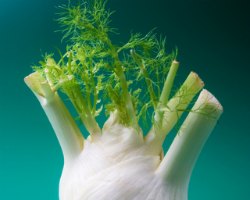
Fennel, a vegetable common to the Mediterranean cuisine, is gaining popularity in kitchens worldwide. And it’s no wonder — the unique, aromatic flavor of fennel is scrumptious on its own or combined with other vegetables, meat, fish, poultry, beans or grains. If you haven’t tried fennel yet, you’re in for a treat. Not only is it versatile and delicious, but its nutritional benefits alone are worth the trip to the grocery store or local farmer’s market. Let’s take a closer look at this delicious and versatile vegetable:
Appearance
Fennel looks like a cross between a celery stalk and an onion bulb, resembling the former more than the latter. It is composed of a white or pale green bulb (usually ranging in size from a large orange to about the size of a grapefruit) on which closely superimposed stalks are arranged. The stalks are topped with feathery green leaves, resembling dill, near which flowers grow and produce fennel seeds. The bulb, stalks, leaves and seeds are all edible.
Taste
Although similar in taste to licorice and anise, fennel has a slightly sweeter and more delicate flavor. When cooked the flavor mellows and loses its licorice-like resemblance and takes on a distinctively unique taste.
History
Fennel is a member of the umbelliferae family along with carrots, celery and parsley. It has been grown throughout Europe since ancient times because it was traditionally used to cure digestive ailments. The ancient Romans used fennel to stave off obesity, while in medieval times the seeds where chewed to stop gastric rumblings. Today, fennel is also cultivated in the United States, Asia and Egypt. The plant grows quickly and requires full sunlight and only the simplest culture in any good garden soil. It is usually available from autumn through early spring.
Nutritional Highlights
Fennel is an excellent source of Vitamin C, a powerful antioxidant and vitamin needed for tissue repair and growth; potassium, a mineral needed to maintain stable blood pressure; and dietary fiber, a necessary component for proper digestion and elimination. It is also a very good source of phosphorous, needed for blood clotting, bone and tooth formation, cell growth and kidney function; folic acid, needed for energy production, immunity, and the production of red blood cells; magnesium, a vital catalyst in enzyme activity and a necessary mineral for calcium and potassium uptake; manganese, a mineral needed for protein and fat metabolism, healthy nerves, immunity and blood sugar regulation; iron, needed for the production of haemoglobin and myoglobin; calcium, vital for the formation of strong bones and teeth; and molybdenum, an essential mineral required for normal cell function and nitrogen metabolism. A 3 ½ ounce serving provides 31 calories as carbohydrates with 3.1 grams of fiber, making this tasty vegetable a healthy choice.
Health Benefits
Fennel is often consumed for its medicinal effects. It can help relieve intestinal spasms, cramps, and gas. A soothing and tasty tea can be made by gently boiling chopped fennel for several minutes on the stovetop.
Selecting and Storing
To ensure maximum freshness, choose fennel with the stems still attached to the bulb. Its branches should be hard and firms and the bulb should be whitish or pale green in color. Fresh fennel will be fragrant and sweet and should be used soon after purchase to take advantage of its aromatic scent. It is best to keep fresh fennel in the refrigerator crisper for a maximum of three days.
Cooking with Fennel
Whether raw, braised, sautéed roasted or grilled, cooking with fennel enhances the flavor of any recipe. When used raw in salads or salsas, it has a refreshing, crisp texture, complementing other raw vegetables. The best way to slice fennel is to do so vertically through the bulb. Cut the stalks away from the bulb at the place where they meet. If your recipe requires diced or julienned slices of fennel, remove the harder core that resides in the center of the bulb before cutting it. Because the stalks are usually tough, they are best used for soups, stocks and stews. The feathery tips can be cut from the stalks and used as a garnish.
Here are some of my favorite quick and easy recipe ideas using fennel:
Braised Fennel
Cut the bulbs in quarters, from tip to root. Season with salt and pepper. Heat some olive oil in a deep frying pan. Sauté sliced garlic in oil until lightly golden. Add 1 cup of pureed tomatoes. Add the fennel to the pan and cover. Cook over low heat for 20-25 minutes until tender.
Roasted Fennel
Cut the bulbs in quarters, from tip to root. Brush fennel with olive oil and season with sea salt, pepper and Chile pepper flakes. Place on a lined baking sheet. Roast on 400 degrees Fahrenheit for 30 minutes or until tender. Turn fennel partway through roasting.
Fennel Salad
Add julienned fennel slices, orange segments, spinach and cooked navy beans in a bowl. Add juice of one orange, splash of balsamic vinegar, a bit olive oil. Season with salt and pepper. Mix well and enjoy.
Fennel Dip
Mix thinly sliced fennel and minced mint leaves with plain Greek style yogurt for a protein packed dip or spread.
References
Murray, Michael N.D. The Encyclopedia of Healing Foods. New York: Atria Books, 2005.










